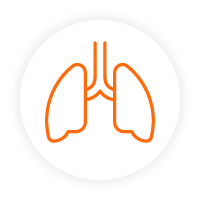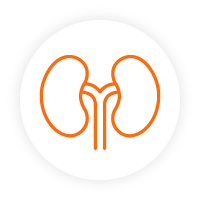

KISQALI® (ribociclib) safety profile in early breast cancer (eBC)
Indications:1
KISQALI in combination with an aromatase inhibitor (AI), is indicated for the adjuvant treatment of patients with hormone receptor (HR)-positive, human epidermal growth factor receptor 2 (HER2)-negative early breast cancer at high risk of recurrence (see section 5.1 of the SmPC for eligibility criteria)
In pre- or perimenopausal women, or in men, the AI should be combined with a luteinising hormone-releasing hormone (LHRH) agonist
Please refer to the Summary of Product Characteristics (SmPC) for the full safety profile and guidance regarding managing adverse events (AEs).
For information on dosing and dose modifications, please click here.
KISQALI 400 mg has a generally manageable and well characterised safety profile1–4
NATALEE study design: (N=5101) international, randomised, open-label, Phase III trial in patients with HR+/HER2– eBC. Premenopausal and postmenopausal women, and men, were randomised to receive either KISQALI 400 mg/day plus NSAI or NSAI alone. The primary endpoint was invasive disease-free survival as per Standardised Definitions for Efficacy Endpoints (STEEP) criteria version 1.0, assessed by the investigator.3
In an exploratory analysis at 4 years, KISQALI 400 mg had a generally manageable and well characterised safety profile with no new safety signals identified after extended follow-up1,2
NATALEE AEs at 4 years (exploratory analysis)2
| KISQALI + NSAI (n=2526) | NSAI (n=2441) | ||
AEIS, % | Any grade | Grade ≥3 | Any grade | Grade ≥3 |
Neutropenia* | 62.8 | 44.4 | 4.5 | 0.9 |
Febrile neutropenia | 0.3 | 0.3 | 0.0 | 0.0 |
Liver-related AEs† | 26.7 | 8.6 | 11.4 | 1.7 |
QT interval prolongation‡ | 5.4 | 1.0 | 1.6 | 0.7 |
ECG QT prolonged | 4.4 | 0.2 | 0.8 | <0.1 |
Interstitial lung disease (ILD)/pneumonitis§ | 1.6 | 0.0 | 0.9 | 0.1 |
Other clinically relevant AEs, % | ||||
Arthralgia | 38.8 | 1.0 | 44.4 | 1.3 |
Nausea | 23.5 | 0.2 | 7.9 | <0.1 |
Headache | 22.9 | 0.4 | 17.2 | 0.2 |
Fatigue | 22.8 | 0.8 | 13.5 | 0.2 |
Diarrhoea | 14.6 | 0.6 | 5.5 | 0.1 |
Venous thromboembolism¶ | 1.1 | 0.6 | 0.5 | 0.3 |
Adapted from Fasching PA, et al. 2024.2
Dose adjustments and discontinuations at 3 years3
| KISQALI + NSAI | NSAI |
KISQALI discontinuation due to AEs | 19.5% | N/A |
NSAI discontinuation due to AEs | 5.1% | 4.4% |
Dose reduction of KISQALI due to AEs | 22.8% | N/A |
Most frequent any-grade AE leading to discontinuation | 9.9% Liver-related∥ | 0.1% Liver-related |
Adapted from Hortobagyi GN, et al. 2025.3
In the KISQALI + NSAI arm, rates of discontinuation due to AEs were consistent and remained stable at 4 years (20.0%), with a <1.0% increase from the 3-year final analysis2
AEs generally occurred early in treatment, allowing for prompt dose adjustments4
For KISQALI, median time to discontinuation due to AEs was 4.17 months (range: 0.10–35.75 months)4
The majority of ≥grade 3 AEs were laboratory findings that were generally identifiable and manageable4
Corresponding frequency category for each AE based on the CIOMS III: very common (≥1/10); common (≥1/100 to <1/10); uncommon (≥1/1000 to <1/100); rare (≥1/10,000 to <1/1000); very rare (<1/10,000) and not known (cannot be estimated from the available data).1
Adverse events in patients with eBC with starting dose of 400mg KISQALI
Adapted from KISQALI Summary of Product Characteristics.1
For further safety profile information, please refer to the SmPC.1
Contraindications1
Special warnings and precautions for use1
Find out more about the safety profile of KISQALI in aBC
Click here to learn more about dosing and monitoring with KISQALI
*Grouped term that combines neutropenia and neutrophil count decreased.2
†Grouped term that includes all preferred terms identified by standardised MedDRA queries for drug-related hepatic disorders.2
‡Grouped term.2
§Grouped term that includes all preferred terms identified by standardised MedDRA queries for ILD.2
¶Grouped term that includes all preferred terms identified by standardised MedDRA queries for venous thromboembolism.2
‖Liver-related: ALT increase 7.1%, AST increase 2.8%.3
**Infections: urinary tract infections, respiratory tract infections, gastroenteritis (only in patients with advanced or metastatic breast cancer), sepsis (<1% only in patients with advanced or metastatic breast cancer).1
††Abdominal pain: abdominal pain, abdominal pain upper.1
‡‡Stomatitis for eBC includes: stomatitis, mucositis.1
§§Hepatotoxicity: hepatic cytolysis, hepatocellular injury (only in patients with advanced or metastatic breast cancer), drug-induced liver injury (<1% in patients with eBC and in patients with advanced or metastatic breast cancer), hepatotoxicity, hepatic failure (only in patients with advanced or metastatic breast cancer), autoimmune hepatitis (single case in patients with eBC and single case in patients with advanced or metastatic breast cancer).1
¶¶Rash: rash, rash maculopapular, rash pruritic.1
‖‖Abnormal liver function tests: ALT increased, AST increased, blood bilirubin increased.1
AE, adverse event; AEIS, adverse event of special interest; AI, aromatase inhibitor; ALT, alanine aminotransferase; AST, aspartate aminotransferase; CIOMS, Council for International Organizations of Medical Sciences; eBC, early breast cancer; ECG, electrocardiogram; HER2, human epidermal growth factor receptor 2; HR, hormone receptor; ILD, interstitial lung disease; LHRH, luteinising hormone-releasing hormone; MATE1, multidrug and toxin extrusion protein 1; MeDRA, Medical Dictionary for Regulatory Activities; NSAI, non-steroidal aromatase inhibitor; OCT2, organic cation transporter 2; QTcF, corrected QT interval by Fridericia’s formula; SmPC, summary of product characteristics.
References
KISQALI (ribociclib) Summary of Product Characteristics.
Fasching PA, et al. Oral LBA13. European Society for Medical Oncology Congress, 13–17 September 2024, Barcelona, Spain.
Hortobagyi GN, et al. Ann Oncol 2025;36(2):149–157.
Barrios C, et al. Oral presentation 113MO. European Society for Medical Oncology Breast Cancer Congress, 15–17 May 2024, Berlin, Germany.
Slamon DJ, et al. N Engl J Med 2024;390:1080–1091; protocol.
UK | July 2025 | FA-11344823
Adverse events should be reported. Reporting forms and information can be found at www.mhra.gov.uk/yellowcard. Adverse events should also be reported to Novartis online through the pharmacovigilance intake (PVI) tool at www.novartis.com/report, or alternatively email [email protected] or call 01276 698370.










